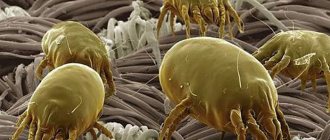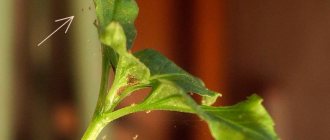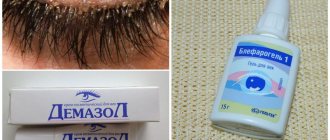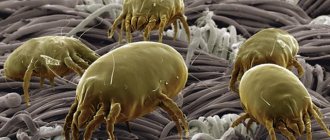In the summer, ticks become more active, which poses a danger to the health of pets. A dog can pick up an insect, since these bloodsuckers are found in grass and trees. With their paws they cling to the fur, after which they easily reach the skin.
It is important to know how to remove a tick from a dog, because with their saliva these insects secrete Babesia, which destroys red blood cells. The liver does not have time to remove the breakdown products of red blood cells, and the kidneys take over this function. Without treatment, the animal dies from oxygen starvation and intoxication.
The tick must be removed within a few hours, otherwise the dog will inevitably become infected. You need to figure out how to properly remove the bloodsucker from the skin. Every owner should become familiar with the consequences of a bite.
Why are ticks dangerous for dogs?
These parasites feed on blood. To do this, they have a specially shaped mouthparts - with a proboscis and hook-shaped spines. With these spines, the insect pierces the dog's skin and is held there, and with its proboscis it sucks out the blood. During a bite, the parasite injects a secretion that reduces pain. This saliva may contain microorganisms that cause serious illnesses: ehrlichiosis, borreliosis or Lyme disease, babesiosis or piroplasmosis. All these diseases are severe and cannot be cured at home. At the first symptoms, be sure to contact your veterinarian.
Regardless of whether a tick is a carrier of pathogenic bacteria, it should not be left on the dog’s body:
- It will disturb the animal.
- It can go deep under the skin and cause inflammation, like a foreign body.
- A tick that has drunk blood is easy to crush. If it is infected, the infection can spread not only to the animal, but also to the owner.
Briefly about the main thing
- Ticks are dangerous pests that can carry diseases: piroplasmosis, borreliosis, ehrlichiosis and many others.
- At the first symptoms of illness after a bite, contact your veterinarian immediately. Even if it's just loss of appetite or depression.
- Inspect your pet yourself after each walk, especially the face, paws, belly and groin area.
- Follow the pest removal algorithm and don’t forget about your safety - wear gloves.
- You should not pour oil or other liquids on the tick so that “it will die and fall off on its own.” This does not work.
- After removal, be sure to take the little scoundrel to the laboratory.
- Treat your pet for external parasites in a timely manner.
Have we answered your question fully enough? If not, post your question in the comments below and our veterinarian will answer it.
Did you like the article? Share it with your friends on social media. networks. This will help them get useful information and support our project.
When and where to look for ticks in fur
In summer and autumn, when parasites are active, you need to examine your dog after every walk.
Short-haired dogs are especially susceptible to ticks, but long, dense hair will not protect against parasites. They just choose areas where the fur is a little shorter. This could be: the muzzle, ears, belly and groin, paws, especially between the toes, next to the pads.
The pet's body must be carefully examined as a whole, without missing individual areas. You can use a comb to part the fur and look as close to the skin as possible. To detect the smallest tick that has not yet had time to suck blood, you can take a magnifying glass.
Symptoms of a tick presence
Having caught on the animal’s fur, the tick does not immediately dig into the skin, but moves around the body for some time in search of a suitable place.
The tick bite is painless, the parasite does not cause any discomfort to the dog and is difficult to notice under a thick layer of fur. Therefore, in the warm season, your pet should be carefully examined after each walk. Parasites like to occupy places where capillaries are located close to the skin, these are:
- muzzle;
- stomach;
- ears;
- neck;
- breast;
- the inner sides of the front and hind legs;
- groin area.
The insect penetrates the body slowly but deeply. Without changing its position, the tick can suck blood for several days, after which it falls off or changes location.
How to rid a dog of a parasite
To remove a tick you need to prepare:
- wash and disinfect your hands, wear sterile or disinfected gloves;
- calm and secure the dog, it is advisable to wear a muzzle, even if the pet is very peaceful: no one knows how the animal will behave in a stressful and painful situation;
- It is advisable to carefully trim the hair at the site of the bite;
- prepare an antiseptic for treating the wound.
If your dog is nervous, he may be feeling pain from the parasite. To soften it, you can treat the skin around the bite with lidocaine.
Mistakes when removing a tick
For the selected removal method to work, you must perform all operations correctly. Typical mistakes that owners make are:
- Significant compression of the insect . Under the influence of force, it may burst or its chitinous layer may be damaged. In this case, harmful substances will enter the bloodstream on the wound, and the proboscis will remain inside.
- Pulling the tick upward rather than twisting it out. It bites even harder, the spines on the proboscis get stuck, and the head is torn off from the body.
- Sudden movements of the owner or dog. The insect may be torn into pieces.
- Leaving the proboscis and paws in the wound . There may be a virus inside the head that will continue to act; also, any part of the bloodsucker is a foreign body and can provoke a secondary infection and allergic reactions.
- No post-processing . The site of suction is an open wound, without disinfection, bacteria can get inside and provoke the development of inflammation.
- Working with your hands without protecting them with gloves . Ticks carry viruses that are also dangerous to humans.
What not to do
To remove ticks from dogs, different methods are recommended. You can't just pull it out. There is a high probability that you will tear off the body of the tick, but the head will remain in the dog’s body. Removing one head is much more difficult at home. And if it is not removed, it will become a source of inflammation.
To remove ixodid ticks, some people advise pouring gasoline, oil, or other viscous or caustic liquids over them. This, of course, will kill the tick, but in agony it can go even deeper under the skin, secreting an increased amount of saliva with pathogenic bacteria. That is, it will only get worse.
You should also not remove a tick simply with your hands. In this case, you can not only tear the insect apart, leaving the head, moreover, when removed, the tick’s body, inflated with blood, will tear. If the tick is on the head, then infected blood can get on the mucous membrane in the mouth, nose, and eyes. It can get on wounds on the body of a dog or person. And because of this, the infection process will worsen.
So, you can’t pull out a tick:
- filling it with oil, gasoline, etc.;
- pulling it out in one motion;
- removing it by hand, without special tools.
The main task is to remove the entire tick without damaging it or leaving parts of it in the animal’s body.
Basic mistakes
A common belief is that the tick must first be doused with oil or nail polish to cut off the oxygen supply, the tick will die and come off on its own.
On the one hand, there is some truth here. The tick actually breathes through its abdomen, and it will actually die if you pour oil on it. Only now he won’t unhook and won’t loosen his grip, but on the contrary! His grip will become stronger and it will be more difficult to reach him. Dying, in a state of agony, it can burrow even deeper into the skin.
And most importantly, during this process he will begin to actively splash saliva inside the dog, and in the saliva of the parasite, as we already know, there are dangerous microorganisms!
Dousing a tick with oil, nail polish or gasoline can only make things worse.
Methods for removing ticks
There are several methods on how to properly remove a tick:
- With tweezers . You can use a regular one, but a curved one is more convenient. It needs to be heated over a fire or disinfected in some other way. The tweezers should be held as close to the dog's skin and parallel to it as possible. The parasite is grabbed not by the abdomen, but by the head. It is not pulled out, but twisted, like a loose tooth, rotated from side to side.
- With a thread . This is a more complex method. A loop is formed from the thread, which is used to wrap around the swollen parasite, like a noose. You also need to pull it out gradually, rocking it from side to side. The method is dangerous because the thread can easily crush the insect and cut off its head.
- Using a syringe . To do this, you need to place a syringe without a needle and with a cut off tip to the dog’s body so that the tick is inside. By pulling out the piston you will create a vacuum. If the tick is not held too tightly, you can pull it out entirely. This method rarely helps, but you can try.
- Twister . This is a special device that looks like a small nail puller. It is found in stores under different names, but their operating principle is the same. They need to pick up the tick and slowly pull it out, making light twisting movements. The advantage of this method is that the parasite remains in the twister, and you don’t have to worry about crushing or tearing it. All dog owners who walk their pets in parks and forests should have such a device so that after a tick bite they can pull it out themselves as quickly as possible.
What is piroplasmosis and how to understand that your dog is sick
Piroplasmosis (also known as babesiosis) is a hemoparasitic disease caused by the protozoa Babesia canis or Babesia Gipsoni. A dog can become infected after a tick bite - along with saliva, the tick penetrates the dog's bloodstream and infects red blood cells - red blood cells that carry oxygen.
- Lethargy, apathy, refusal to eat;
- Fever (normal dog temperature is 37.5 – 39.0°C).
- Yellowness of the mucous membranes, sclera and skin;
- Urine is deep orange or red in color.
If any of these symptoms occur, visit your veterinarian immediately! Without treatment, piroplasmosis is fatal!
How to remove a tick under the eye
Dogs also have thin skin under their eyes. The difficulty in removing ticks from this area is that the dog most likely will not allow any manipulation of itself. She will jerk her head, because of which, firstly, you can get tweezers, a twister or a syringe in the eye, and secondly, you can crush or tear the tick. To remove the parasite, you need one person to hold the head tightly, and the other to pull out the insect.
If you have a helper and can secure the dog's head, try to remove the pest yourself. If you are afraid that you are not a good judge and may harm your pet, it is better to contact a veterinarian.
How to examine an animal
The Ixodid tick is relatively large. In a hungry state, its body length can be 2 mm. After sucking blood, it increases in size and can reach 1.5 cm.
The main weapon of the ectoparasite is the proboscis, which consists of upper and lower jaws, a base and a pair of tentacles. The upper jaws cut the skin, the lower jaws are used for fastening.
It is believed that ticks fall from tree branches. But it is wrong. The bulk of ectoparasites are located closer to the ground, on grass, both fresh and dry. There are many of them in the forest, especially dense ones, near a river, in a meadow. They do not climb to a height of more than 1.5 meters above the ground.
When a tick gets on the fur, it does not immediately attach itself to the skin, so there is always time for inspection. It needs to be done every half hour.
In dogs with short hair, ticks are clearly visible. Representatives of long-haired breeds are combed with a fine comb against the growth of the coat after each walk.
Already attached parasites can be identified by stroking the dog against the growth of the fur. You will feel a lump to the touch.
What to do if your dog won't let you remove a tick
If an animal is worried, it means it is in pain. It is necessary, firstly, to calm him down, and secondly, to numb the site of the tick bite. Near the parasite, you can anoint the skin with lidocaine, which is sold as a spray or in ampoules. There is no need to inject it, just apply it to the skin. This is a local anesthetic; it will not harm the animal and will not in any way affect the process of removing the tick, but will reduce pain.
If possible, it is worth carrying out the procedure together, so that one person holds the dog, fixes it, does not allow it to move, and the second is engaged in extracting the parasite. This will be faster, easier and safer for your pet.
You should not give your dog pills or other sedatives without the advice of a veterinarian.
Once the tick is pulled out, it must be disposed of. If possible, you can put it in an airtight jar and send it for analysis to make sure it is not infected. This must be done within two days while he is alive. If it is not possible to send for analysis, the tick must be destroyed, taking precautions. To be safe, you can burn it.
When you have removed the tick, make sure that no parts of it remain on your pet's body. The wound must be washed with chlorhexidine, hydrogen peroxide, iodine or any antiseptic. It is not recommended to use green stuff.
What to do with the dog after removal? Observe her well-being and behavior. The incubation period for diseases transmitted by ticks can be 5–10 days. During this time, it is forbidden to vaccinate the animal and overload it physically. If a dog refuses food, gets tired quickly, lies in a certain place for a long time without showing usual physical activity, the whites of its eyes and skin have turned yellow, and its breathing quickens, you should immediately contact a veterinary clinic. Diseases caused by ticks can be fatal quite quickly.
Why Simparica?
Many people are surprised - how can a tablet save a dog from a tick? It's a pill, it can't affect the skin. How can it! The active ingredient of Simparica, sarolaner, is absorbed from the stomach and distributed through the bloodstream throughout the body. The tablet begins to work within 3 hours after use, and reaches the maximum degree of protection against ticks after 12 hours.
The mechanism of action of Simparika is such that after a tick bite, the active substance affects the nervous system of the parasite, and it dies before the hemoparasites have time to penetrate the animal’s bloodstream. At the same time, the dog’s body is structured differently and Simparika does not have a negative effect on the nervous system and the functioning of the animal’s internal organs.
What to do if your head comes off
If the tick's head or part of it remains under the skin, these remains must be removed. If possible, it is better to contact a veterinarian who will make an incision, remove everything and treat the wound. But if this is not possible, you can remove the head yourself using a fire-heated needle. They pick up the head like a splinter and pull it out. The main thing during this procedure is that the dog does not get nervous. You can treat the area around the wound with an anesthetic, such as lidocaine spray. After removing the head, the wound must be washed and disinfected.
If, some time after extraction, a lump forms at the site of the bite, this indicates that the head or part of it was not completely removed. An inflammatory process with suppuration began in the wound. In this situation, you need to go to the clinic to have the wound cleaned. You may have to make an incision to do this. To avoid this, the entire tick must be removed, and after removal, make sure that no parts of it remain inside the animal.
Features of ear mites
Otodectosis is a disease caused by a microscopic parasite that lives only in the dog's ears. It is possible to see a tick only under a microscope, but traces of its vital activity are clearly visible, this is a black coating inside the ear. The animal often scratches its ears, as ear mites in dogs cause itching.
These parasites pierce the skin in search of food: Lymph and blood. It is possible to determine otodectosis after two weeks of damage to the ears.
Symptoms become noticeable:
- Anxiety;
- The dog rubs its ears;
- Often scratches ears with paws;
- Tilts his head to one side.
Having examined the ears, you can see black and dark brown plaque, an unpleasant odor, and wounds from scratching. Treatment is carried out using several methods: external and injection.
The external method involves treating the ears with ointments or sprays after thoroughly cleaning the ears of plaque with ear sticks. Injection is used in advanced cases.
The dog is injected subcutaneously with drugs that are lethal to parasites. When cleaning the ear, you must use hydrogen peroxide or chlorhexidine. Then treat with a special preparation: “Stomazan”, “Bars”, “Amitrazine”, “Butox” or any other special agent.
Prevention methods
To avoid having to remove the tick from the dog’s body, it is worth protecting the pet. For this purpose, there are acaricidal drops on the withers. Anti-tick tablets and special collars impregnated with tick-repellent compounds are also sold. If your dog is walking on a private dacha, it is worth treating it yourself against ticks. For this you can use, for example, Medilis-Ziper.
Working aqueous emulsions are prepared immediately before use. To do this, the product is mixed with tap water from nearby bodies of water, stirring constantly and evenly for 5 minutes. The finished emulsion should be used within 8 hours. To apply the product, spray equipment is used, designed to spray solutions and emulsions of insecticides over surfaces. The effectiveness of the product against ticks in the grass litter is about 1–1.5 months. If there is a significant amount of precipitation, the effectiveness of the product may decrease. If necessary, due to the presence of ticks in the treated area, it can be re-treated.
Also, before a walk, you can treat the fur and collar or clothing (if the dog walks in clothes) with a repellent, for example, produced by MediLIS Laboratories LLC with the acaricidal-repellent agent Medilis-Comfort. Clothes and other fabric and leather products should be processed in the open air (outdoors). Place clothing and direct the product stream in the direction of the wind. Spray on products from a distance of 20 - 25 cm from them, holding the package in an outstretched hand at the rate of 1 press on the spray head per area of 10 cm X 10 cm (1 dm2). Dry the clothes (at least 2 hours) and put them on. Re-process clothes after 15-20 days or after washing. When using chemicals, you must strictly follow the instructions and do not allow the dog to lick itself after application. Medilis-comfort, produced by the manufacturer in a convenient aerosol package, is effective against fleas, midges, midges, mosquitoes, horse flies, mosquitoes, adults, and Ixodes ticks.
Ways to protect yourself from a bite
Preventive measures against tick bites include the use of the following protective drugs and ammunition:
- Tick collar . A long-lasting protective agent that does not kill the insect, but repels it, thanks to its special impregnation. It usually acts not only on ticks, but also on fleas and mosquitoes. Available in different sizes, selected depending on the size of the pet. The effect is achieved only by constantly wearing the product.
- Drops . The drug is long-acting, the period of protection depends on the specific brand. The drops are applied to the dog’s withers; they can not only repel, but also destroy ticks and fleas. They cease to act upon contact with water, and allergic reactions may occur.
- Sprays . The drug can repel or kill the pest depending on the composition. As a rule, the animal is sprayed with sprays before a walk. May cause stomach problems if licked, as well as allergic reactions.
- Dry mixes . It is applied to the fur, as a rule, to combat existing insects.
- Shampoos . Validity up to 1 week. More often it acts as an auxiliary agent.
- Pills . When taking the drug, the toxic composition acts on the pest through the blood on which it feeds. It is not always well tolerated by dogs and there are side effects.
- Vaccination against piroplasmosis. It is carried out in two stages and provides 75-80% protection.
- Folk remedies (rinsing wool in a decoction of geranium, washing with tar soap, applying essential oil of tea tree, citrus fruits, lemon balm, cloves, lavender to the hair). Can only be used as an aid.
- Overalls . It protects most of the body from ticks, in addition, the bloodsucker is clearly visible on it. However, the lower part of the paws remains open and accessible for penetration under clothing.
Regardless of the chosen method of protection, you should not be lazy to examine your pet after a walk, and especially upon returning from the forest or field. No drug can provide guaranteed 100% protection.
We recommend that you read a useful article on the topic: “Protecting your pet from ticks: a review of the best remedies.”
It is advisable to check the animal’s fur for the presence of a bloodsucker even while on the street, since male insects, unlike females, do not remain on the body for a long time; upon returning home it will not be possible to detect it, although the bite will have already been made and the virus will begin to act.
Unfortunately, ticks are not uncommon; they can be found not only in the forest, but also in the alley near the house. The diseases they carry are dangerous for dogs and humans, so special means of protection against their bite are required. If suction cannot be avoided, competent and quick removal of the uninvited guest, as well as timely initiation of treatment, can help the pet.
5 / 5 ( 1 voice )
What to do after deletion
Destroy small insects, preferably with open fire. Parasites in a tightly closed bottle can remain viable for months. Place a large, blood-fed parasite in a bottle so that, if necessary, you can send it to the laboratory to identify pathogens. Small settlements are deprived of equipment, specialists, and reagents for analysis. The cost of a comprehensive study using the PCR method is 1500-2000 rubles. Within 1-3 days you will receive the result.
Outbred dogs may be immune to piroplasms; the disease occurs in a chronic or asymptomatic form. Pedigree animals have a hard time withstanding the invasion. When the dog’s temperature rises to 41-42 degrees, loss of appetite, dark urine, seek veterinary help.
If a hunting dog is sick and has been cured, it cannot be used this season. The dog is prescribed medications according to the diagnosis. Piroplasmosis (babesiosis) is considered the most dangerous disease in dogs. To make a correct diagnosis, you need not a tick, but a drop of blood from the pet’s ear, more than 14 days after the bite. To monitor the effectiveness of treatment, the analysis is repeated after 2 months.
Write your impressions of the article and questions in the comments.
Danger
Diseases that cause parasite bites are presented in the table.
| Disease | Description |
| Bartonellosis | Signs: fever, joint inflammation, sudden weight loss, development of anemia. May cause sudden death of a pet. |
| Ehrlichiosis | The symptoms are similar to a high fever. Can be transmitted to people. |
| Hepatozoonosis | The development of the disease occurs when the parasite is swallowed. Signs: discharge from the eyes, pain throughout the body, severe fever. |
| Borreliosis | The most dangerous disease. Main symptoms: weakness, lack of appetite, fever, lameness. The disease poses a serious danger to humans. |











